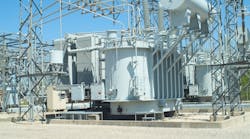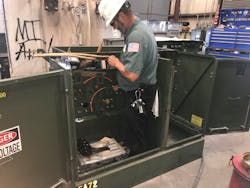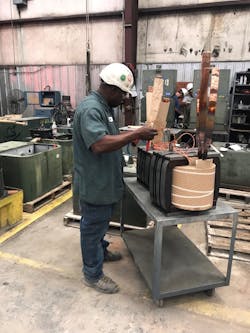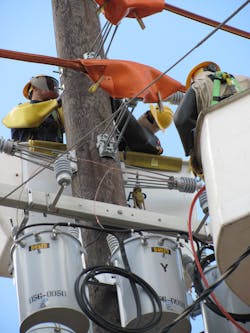Large electric transformers are inconvenient machines. They are large and heavy, which means they usually need to be delivered by sea freight, not air freight, which would be faster. They must be designed by specially trained engineers and assembled by experienced technicians. They require expensive and often rare materials, like copper, specifically milled steel, high-cellulose paper and other hard to come by components. They have extremely exacting technical specifications, which limits production and keeps new producers out of the market. They must be built to exacting standards for safety and reliability, which requires extensive testing and often customized manufacture.
As inconvenient as large transformers are, the power grid as we know it could not function without them, or even without enough of them. According to the Energy Department’s Office of Electricity, over 90 percent of the electricity consumed in the U.S. passes through a large power transformer.
Before a pandemic sent shudders through global supply chains, the U.S. was 82% reliant upon imports to meet its need for large transformers, according to a 2020 study by the Commerce Department. The U.S. power grid’s increasingly talked-about issue with aging equipment also extends to transformers. The average age of installed large transformers in the U.S. is about 40 years, which is at the end of their expected operational life. Older transformers are more likely to fail and need replacement, but a look at these statistics is enough to show that the U.S. was already sitting in a risky spot before supply chains became a common topic in the mainstream.
Today, people in the industry are reporting longer lead times to get needed equipment, including transformers. Jim Templeton, a third-party consultant to POWER Engineers with 40-plus years in the industry and his own consulting firm, JB Templeton Consulting LLC, said an aging power grid and ongoing supply chain issues are mixing in disruptive ways.
“I deal with a number of different clients on the utility side and about a year ago we started to see lead times from transformer manufacturers creep up. Before the pandemic, you could get a large transformer ordered in less than a year. Today that is rare. A relatively large manufacturer in the US was at about 38 months. That used to be 38 weeks if you were to compare,” Templeton said.
The dramatically lengthening lead times for needed parts is throwing utilities’ emergency contingency plans into confusion.
“The danger I see in this is you don’t know in that 38-month period will you lose another transformer and what will you then need to repair that spot on the grid? Our grid is, I think, fairly old. There’s a lot of aging transformers on the grid. Dealing with my clients, they are trying to come up with how do I respond to an emergency situation,” Templeton said.
Scott Marshall. principal engineer with POWER Engineers, said equipment distributors used to have reservation slots for emergency situations, but now are not able to find used transformers.
“When I was with a utility, we could go to a transformer supplier in an emergency and get what we needed in about six months. That quick replacement we used to be able to get, you might be waiting a year or more. They can’t find those slots for you,” Marshall said. “They may put in a dicey unit just to get the power flowing, knowing that they may have to replace it in one or two years.”
In a video interview with T&D World, Templeton said many utilities get their equipment, including transformers, from an approved supplier list. The tightening of certain supplies led to utilities going off their usual lists and make compromises just to get needed gear.
“[Utilities having trouble finding equipment] now have to open up the doors to a much larger set of potential suppliers, ones they’ve never had a relationship with before just to get what they need. That might not sound horrible, but these relationships have a positive effect on the procurement slide,” Templeton said. “Now people are having to purchase from companies and countries that they never worked with before.”
It is still relatively easy to get a 10 MVA transformer from a supplier utilities know and are used to dealing with, but a 1000 MVA transformer might not be available from a reliable source, Templeton said.
Root Causes
The Energy Department is looking into the drivers of these shortages, and they are complicated and global. According to a “deep dive” supply chain assessment released by the DOE in February 2022, produced as part of an executive order to investigate supply chain disruptions, raw material shortages are to blame for the manufacturing shortfalls of critical power grid equipment like transformers. The report focuses on raw material supplies, such as rare earth metals for energy storage batteries. However, just as much time is spent on grain-oriented electrical steel (GOES), which is a critical component in transformer cores and laminations.
The GOES it takes to build a transformer can make up a quarter of the finished good’s production cost. In a large transformer weighing some 400 tons, GOES is a large part of that weight.
According to a Commerce Department report from October 15, 2020, the U.S. manufacturing bas for GOES is on life support, with only one company, AK Steel, Inc., a unit of Cleveland Cliffs Inc., milling GOES at two factories in Ohio and Pennsylvania. These factories are not profitable, and the CEO has said the company may close the last GOES plants in the U.S., leaving the country entirely dependent on imports, according to the Commerce Department. Most of the GOES in the world comes from China (including Hong Kong), Japan, France, German, India, Poland, the Czech Republic, Russia, Brazil and South Korea.
Also, much of this supply is used internally and not exported, the Commerce Department notes. This is because countries like China and India are in the process of large power grid buildouts.
“In contrast, the U.S. market is mature, and demand for transformers is largely based on upgrades and replacements of aging infrastructure, including efforts to install smart grids to increase energy efficiency. The average transformer in the United States is 38 years old, with 70 percent of U.S. transformers older than 25 years,” according to the Commerce Department report, “The Effects and Imports of Transformer Components on the National Security.”
The Commerce Department said this situation is a threat to both the bulk power grid and national security. Perhaps underscoring the seriousness of the situation, many portions of the report are redacted. The report goes on to identify 16 critical sectors of the economy that could not operate without large transformers, including power plants, hospitals, waste systems, critical manufacturing, transportation systems, large commercial facilities and government facilities including military bases.
Impact on Utilities
Michael Ho, Director of Support Services at Hawaiian Electric, said his utility has seen lead times jump from 16 weeks to 142 weeks for single-phase pad-mounted transformers. Just within the past few months, lead times have more than doubled.
“We have been able to rely upon our current inventory levels to cover short-term demand thus far, and have not had any significant impacts or delays to projects as of yet.
However, while we have a steady stream of orders in place with transformer manufacturers to replenish our inventory, there is a growing concern that we could deplete our stock if demand is higher than forecasted or if the lead times continue to increase,” Ho said. “Without enough transformers in inventory, we will not be able to cover all of the transformers that are needed for projects such as new customer installations, upgrades, maintenance and emergency replacements.”
Ho said Hawaiian Electric and other utilities are urging developers and contractors to plan carefully to minimize impact on end users, communicating their plans and equipment needs to utilities as far ahead as possible to allow for longer order times.
“Projects that require non-standard transformers that aren’t frequently used have a higher potential risk since limited inventory is kept on hand for these types of transformers and there will be a significant delay in ordering and receiving new transformers,” Ho said.
Prices, along with lead times, are ballooning as well as the materials and freight costs are increasing.
“We’ve also had to dedicate much more time and cost to managing the situation, including added communication and planning. There’s also the potential of delayed revenue from new services should customer projects get delayed,” Ho said. “we’re working more closely and having more frequent meetings with our distributors to get up-to-date information on the production and delivery of our orders. We’ve also had to reach out to additional manufacturers and distributors as we seek out additional sources of supply for our materials.”
Ho said his utility is looking into repairing or refurbishing used transformers as a way to boost inventory levels and sidestep long lead times.
“We will also need to look at all alternatives for utilizing other substitute (e.g. higher kva) transformers that may be available or redesigning the system on a temporary or permanent basis,” Ho said.
Rebuilding Back Better
Scott Marshall said this might not be a desirable option for many utilities as repairing and refurbishing can be expensive.
“I haven’t had one refurbished for a while and I’m always reluctant to do it,” Marshall said. “If it’s an older unit, say 30 years old, to really refurb it, you spend a lot of money on it. Sometimes as much as 80% as new.”
Transformer components like gauges, bushings and low-tap changers have to be replaced when a unit gets too old. Besides this, many refurbishment facilities may not have the robust testing capabilities they once did, which can lead to more core losses and less efficiency.
Jim Templeton said in his time managing a large transformer manufacturing facility in the U.S., the refurbishment industry was more developed than it is today.
“Scott said it cost 80% of new to send a unit to a place like that, and we averaged about 75% of the new price. But our advantage was lead time. We could turn it around quicker than the OEM guys could turn it out,” Templeton said.
2022 would be an ideal market for a refurbisher. However, in the 2000s, it became cheaper to buy new large transformers and many remanufacturers went out of business as transformers became “throw-away items,” Templeton said.
This touches upon another driver of transformer scarcity in North America. Besides a lack of materials, there is a lack of manufacturing capacity and the skilled engineering workforce to bring production up to where it needs to be.
“I am often asked where I can go to get an engineer,” Templeton said. “My answer usually was Ukraine, which is not easy to get into now. India also has universities with those programs because they have transformer industries and wanted to have workers to go into those factories. The reason why U.S. schools are not teaching these programs is because the manufacturing jobs left.”
Marshall said manufacturers reported to him a scarcity of skilled labor.
“They are having a lot of trouble finding technicians. When Covid hit, the factory environment became more dangerous, so they had people leave who didn’t want to work in that risky environment. As they tried to bring people back on, it can take at least a year to train people,” Marshall said.
Companies often run lot of training programs, but sometimes cannot recoup their investment when people will move companies after getting their training, Marshall said. It is also challenging to get younger workers to relocate to where they are needed to do the job.
“The younger work force, they say, may not want to pay their dues,” Marshall said. “In some places, the cost of living is so high, which also makes finding skilled labor hard.”
Manufacturing Issues
The protracted pandemic, supply chain and logistical concerns interrupted transformer manufacturing in 2020 and 2021, said Bill Miller, Senior Vice President, Marketing and Sales for Hitachi Energy’s North American Transformer Business.
“This situation has not improved in 2022 – lead-times continue to be long, and customers continue to place advanced orders to respond to these longer lead times. The situation has actually worsened since the start of the year,” Miller said.
Miller said a confluence of issues are to blame, including regional constraints on core steel and conductor materials; growing transportation expenses as well as delays at ports and railways; and the additional tariff costs that apply to goods imported from foreign countries.
“Labor shortages and global trade difficulties do play a big role. The primary shortfall is simply lack of overall investment in the U.S. (by the industry, broadly) to expand manufacturing capabilities for core materials (steel) needed to produce transformers,” Miller said in an email to T&D World.
About 75% of the cost to make a transformer is tied directly to a commodity whose price is subject to constraints and wild swings in cost: specialized steel, copper and oil. All of these have been climbing in price.
Miller said large players in the transformer sector, like Hitachi, will be able to mitigate some of the effects via economies of scale and by drawing upon the capacity of facilities from other parts of the world.
“On the distribution transformer side, utility companies should collaborate to standardize their requirements and reduce variation in designs. More consistent designs would enable simplified and more efficient supply chains,” Miller said, suggesting a possible solution.
In April 2022, the Biden administration introduced programs as part of the $1.2 trillion Infrastructure Investment and Jobs Act to provide $20 million in rebates to replace old distribution transformers and upgrade electric motors. The transformer program is open to utilities and includes $10 million that will be available until it is spent. The DOE estimates applications will open in the third quarter of 2022.
Miller said transformer remanufacturers are under the same constraints OEMs are, however.
“Given the current market conditions, refurbishment doesn’t save a great deal in terms of either time or money and doesn’t do anything to relieve the overall supply chain constraints we are currently seeing,” Miller said.
Even so, transformer service providers are working in unfamiliar new ways to help address the shortage.
“Recondition manufacturers are working together to help each other with supply gaps. Within the industry, competitors are buying/selling transformers from each other to support the customer base,” said Barbara Beaubien, Vice President of Sales and Marketing at Emerald Transformer, which provides a range of transformer services, including remanufacturing.
Emerald Transformer is building a new plant in Waco, Texas to better support its customer base and the state of Texas. Growth in residential construction, in addition to the aging U.S. grid, are powerful drivers affecting the transformer industry, Beaubien said.
“Many more utilities are refurbishing transformers now that hadn’t considered it before they faced the transformer supply shortage with OEMs,” Beaubien said.
After initial tests, transformers are equipped with new gaskets, components and oil with additional testing throughout the rebuild before sanding, priming and painting and a final testing, Beaubien said. New transformers can take as long as two years to be delivered, and most OEMs are quoting 52 weeks plus for padmount transformers. Refurbished transformers can be available in a couple of months in most cases, Beaubien said.
In the Meantime
Templeton said this is a long-term problem with no easy answers, and said utilities need to act accordingly.
“If I was a utility in this position, I’d do everything possible to protect the transformers I have,” Templeton said.
This could include deploying protective relaying, audits of insulation coordination and making sure units are protected from incoming transients and other potential sources of physical damage.
“It appears to me that over the years, the utilities have had more internal pressures brought on them to reduce maintenance costs. PUCs are trying to keep down electric costs, and what I see is utilities are not necessarily given a full complement of dollars to do maintenance,” Templeton said.
This leads to utilities performing condition-based maintenance rather than full maintenance. So a utility may put off vegetation management, then trees fall on lines and transformers explode, thus contributing to a problem affecting the entire industry.
The U.S. power grid, Templeton said, was built differently from the start, using a different engineering philosophy.
“In Europe, they might have two equally sized units sharing the load. So, they split the load in two by running them parallel,” Templeton said. “Our philosophy was we use the asset. It has a nameplate and we use it up to that. In other places around the world, they don’t do that. We will work the livin’ daylights out of our existing units.”





